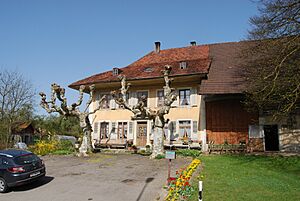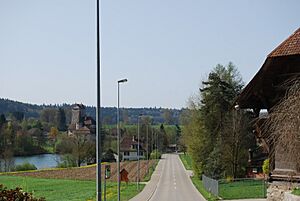Schwarzhäusern facts for kids
Quick facts for kids
Schwarzhäusern
|
||
|---|---|---|
 |
||
|
||
| Country | Switzerland | |
| Canton | Bern | |
| District | Oberaargau | |
| Area | ||
| • Total | 3.79 km2 (1.46 sq mi) | |
| Elevation | 427 m (1,401 ft) | |
| Population
(Dec 2020 )
|
||
| • Total | 533 | |
| • Density | 140.6/km2 (364.2/sq mi) | |
| Postal code |
4911
|
|
| Surrounded by | Wolfwil, Wynau, Aarwangen, Bannwil, Niederbipp, Kestenholz | |
Schwarzhäusern is a small town, also called a municipality, located in Switzerland. It's part of the Oberaargau district in the Canton of Bern.
Contents
History of Schwarzhäusern
Schwarzhäusern has a long history! Its first name was Rufshausen, recorded around the year 1100 as Rudolfshausen. The name Schwarzhäusern first appeared in 1677 as Schwartzenheüßeren.
People lived in this area a very long time ago. Tools made of flint from the Stone Age (Mesolithic and Neolithic periods) have been found here. There are also old graves from the early Middle Ages at a place called Klebenrain.
By the 1200s, a bridge was built over the Aare river. This bridge connected the village to Aarwangen, which was an important center nearby. In 1432, Aarwangen came under the control of Bern, and Schwarzhäusern became part of Bern's territory too.
For a while, Bern and Solothurn shared control over the church area, or parish, of Niederbipp, which included Schwarzhäusern. But by 1463, Bern had full control. After the French invasion in 1798, Schwarzhäusern became part of the District of Wangen. It stayed in the Wangen district until 1871, when it joined the Aarwangen district.
In the 1600s and 1700s, many people in Schwarzhäusern started weaving at home to earn extra money. This was called a cottage industry. It helped families besides farming. In the 1800s, farming became more modern, so fewer workers were needed. This meant many people had to move away to find jobs.
Today, farming and small businesses provide only a small number of jobs in Schwarzhäusern. About three-quarters of the people who work here travel to nearby towns for their jobs. The town shares a high school with Bannwil and Aarwangen, and a special high school (called a Gymnasium) with Langenthal.
Geography and Landscape
Schwarzhäusern covers an area of about 3.7 square kilometers (1.4 square miles). A large part of this area, about 52%, is used for farming. Forests cover about 33.8% of the land. Buildings and roads make up about 10.3%, and rivers or lakes cover about 2.9%.
Most of the built-up area is for houses and other buildings (5.8%). Roads and other transport areas make up 3.4%. Power and water systems take up a small part, about 1.1%. In the forested areas, 31.7% is dense forest, and 2.1% has orchards or small groups of trees. For farming, 40.9% is used for growing crops, and 10.6% is for pastures where animals graze. All the water in the town is from flowing rivers.
Schwarzhäusern is located in the Oberaargau region, which is part of the Swiss plateau. It sits on the left bank of the Aare river, right on the border with the Canton of Solothurn. The municipality includes the main village of Schwarzhäusern, plus smaller villages called hamlets like Rufshusen and Moosbach. There are also scattered farmhouses.
At the southern end of the municipality, the Aare river forms a reservoir. This reservoir is created by the hydroelectric power plant in Wynau, which uses water to make electricity.
On December 31, 2009, the old district of Amtsbezirk Aarwangen was closed. The next day, January 1, 2010, Schwarzhäusern became part of the new Verwaltungskreis Oberaargau district.
Coat of Arms
The blazon (official description) of Schwarzhäusern's coat of arms is: Argent on a Base Vert two Houses Sable and in chief a Mullet Azure. This means it has a silver background, a green base, two black houses, and a blue star at the top.
This coat of arms is an example of "canting". This means the design hints at the name of the place. In German, "Schwartz" means black, and "häusern" means houses. So, the two black houses on the coat of arms represent the name Schwarzhäusern!
People and Population (Demographics)
Schwarzhäusern has a population of about 480 people. About 2.9% of the people living here are foreign nationals. Over the last ten years (from 2000 to 2010), the population grew by about 9.8%. Most of this growth was due to people moving into the town.
Most people in Schwarzhäusern (about 97.5%) speak German as their main language. A small number speak French or Serbo-Croatian.
In 2008, about 50.4% of the population were male and 49.6% were female. Most people (about 34.7%) were born in Schwarzhäusern. Many others were born in the same canton (37%) or elsewhere in Switzerland (20.8%). About 5.7% were born outside Switzerland.
Children and teenagers (up to 19 years old) make up about 23.3% of the population. Adults (20-64 years old) are the largest group at 59%, and seniors (over 64 years old) make up 17.7%.
In 2000, there were 167 single people and 218 married people in the town. There were also 27 widows or widowers and 26 divorced individuals.
The town had 46 households with only one person and 10 households with five or more people. Most apartments (95.1%) were lived in all the time. In 2010, new homes were being built at a rate of about 2.1 new homes for every 1000 residents.
The chart below shows how the population of Schwarzhäusern has changed over time:

Economy and Jobs
In 2011, Schwarzhäusern had a low unemployment rate of 1.55%. In 2008, there were 105 people working in the municipality.
Jobs are usually divided into three main types:
- Primary sector: This includes jobs that get raw materials directly from nature, like farming. In Schwarzhäusern, 18 people worked in this sector, with 8 businesses.
- Secondary sector: This involves making things, like in factories or construction. There were 23 people working in this sector, with 6 businesses. Most of these jobs (20) were in manufacturing.
- Tertiary sector: This includes jobs that provide services, like shops, hotels, or schools. There were 64 people working in this sector, with 10 businesses. Many of these jobs (45) were in sales or vehicle repair.
In 2008, there were 88 full-time equivalent jobs. This means if you add up all the hours worked, it would be like 88 people working full-time.
Many people who live in Schwarzhäusern travel to other towns for work. In 2000, 37 workers came into the municipality for their jobs, but 179 workers left to work elsewhere. This means more people leave Schwarzhäusern for work than come in. About 8% of workers used public transportation, and 65.1% used a private car to get to work.
Religion
Based on the 2000 census, about 10.3% of the people in Schwarzhäusern were Roman Catholic. The largest group, about 82.6%, belonged to the Swiss Reformed Church (a type of Protestant church).
A small number of people (about 0.91%) were members of an Orthodox church. About 3.20% belonged to other Christian churches. There was also 1 person who was Islamic. About 2.74% of the population did not belong to any church, meaning they were agnostic or atheist. A small group (1.60%) did not answer the question about their religion.
Education
In Schwarzhäusern, about 47.5% of the people have finished non-mandatory upper secondary education. This is like high school after the required years. About 9.1% have gone on to higher education, either at a university or a specialized college (called a Fachhochschule).
The Canton of Bern has a specific school system:
- One year of optional Kindergarten.
- Six years of Primary school.
- Three years of required lower Secondary school. Students are grouped based on their abilities.
After lower Secondary, students can continue their education or start an apprenticeship to learn a trade.
During the 2009-2010 school year, 74 students attended classes in Schwarzhäusern. There was one kindergarten class with 14 students. The municipality had two primary classes with 36 students. There was also one lower secondary class with 24 students. A small number of students (4.2%) were not Swiss citizens, and 4.2% spoke a different language at home than the one used in the classroom.
In 2000, 9 students from other towns came to school in Schwarzhäusern. However, 18 students from Schwarzhäusern went to schools outside the municipality.
See also
 In Spanish: Schwarzhäusern para niños
In Spanish: Schwarzhäusern para niños







